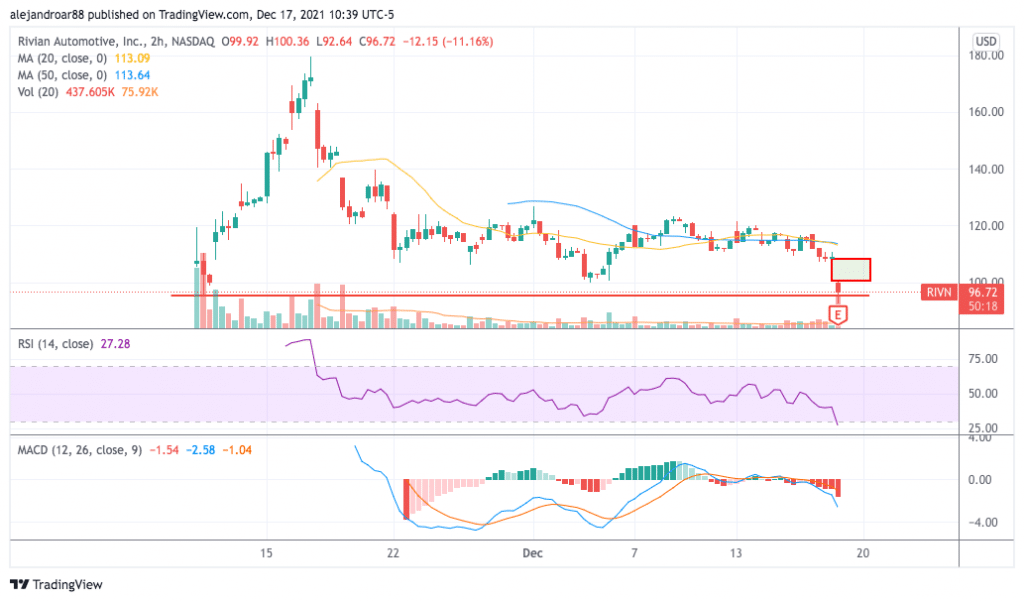Rivian Stock Down 12% Today – Time to Buy RIVN Stock?
Please note that we are not authorised to provide any investment advice. The content on this page is for information purposes only.
The price of Rivian stock is declining 12% in today’s early stock trading activity following the release of the firm’s first quarterly report since going public as losses widened compared to the same period a year ago.
For the three months ended on 30 September, Rivian reported GAAP operating losses of $776 million compared to $288 million it shed a year ago while GAAP net losses accelerated to $1.23 billion due to a negative adjustment in the fair value of some convertible notes.
Even though losses were milder than the $1.14 billion analysts expected, the company’s cash burn may have spooked market participants as Rivian reported $2.9 billion in negative free cash flows during the period, meaning that the company ate up all of the money it raised during its initial public offering (IPO).
From that total, around $1.15 billion were disbursed in this past quarter. Meanwhile, the firm reported total cash and equivalents of $5.2 billion along with an adjusted cash figure of $19.9 billion that includes $13.5 billion in net proceeds obtained from the exercising of options held by underwriters who may opt to sell further shares to investors if market conditions are favorable.
What could be expected from this pre-revenue EV stock as we get closer to the beginning of 2022 and following the release of this first quarterly report? In this article, I’ll be assessing the price action and fundamentals of RIVN stock to outline plausible scenarios for the future.
67% of all retail investor accounts lose money when trading CFDs with this provider.
Rivian Stock – Technical Analysis

Today’s decline in Rivian stock is pushing the price below its post-IPO lows and puts the issue only 21% above its IPO price of $72 per share.
Meanwhile, the latest downtrend experienced by Rivian has pushed its price almost 48% below its post-IPO peak of $179.5 per share and this decline emphasized the significant FOMO that took place after the company went public.
A corner of the investment community sees Rivian as a potential rival to Tesla even though the firm has not yet delivered its first working vehicle.
Today’s decline below the $95 support area highlighted in the chart could be a sign of weakness in the short-term outlook of RIVN stock and momentum indicators are supporting this view as the Relative Strength Index (RSI) has moved to oversold levels for the first time since the stock hit the trading floor.
Meanwhile, the MACD has drifted below the signal line already and negative histogram readings are progressively increasing. This further supports a short-term bearish outlook.
Moving forward, a decline below the $72 IPO price could lead to an acceleration in the downtrend that RIVN stock has seen lately as pre-IPO stakeholders may take some gains before the price gets any lower.
Rivian Stock – Fundamental Analysis
The latest decline in Rivian stock has poured some cold water into the post-IPO rally that pushed the company’s valuation to over $100 billion at some point.
Before investing in this company, investors should be aware of some important risk factors.
First, Rivian is highly dependent on the purchase orders coming from one major client – a subsidiary of Amazon (AMZN) called Amazon Logistics.
“While the EDV Agreement [with Amazon] provides that we will be reimbursed for certain development costs, it does not include any minimum purchase requirements or otherwise restrict Logistics from developing vehicles or collaborating with, or purchasing similar vehicles from, third parties.”, the company states in its risk factors disclosure.
The disclosure continues: “The EDV Agreement may be terminated by either party with or without cause, subject to compliance with certain termination provisions. If we fail to adequately perform under the EDV Agreement, if fewer EDVs are purchased than we anticipate, or if either party terminates the EDV Agreement for any reason, our business, prospects, financial condition, results of operations, and cash flows could be materially and adversely affected.”
That the near-term feasibility of the business relies on an agreement with a single customer is a first red flag that investors should keep in mind before entering a long position in Rivian stock at this stretched valuation.
Moreover, the company’s cash holdings may be insufficient to fully cover the significant capital expenditures that the firm must make to mass-produce its electric vehicles. This is another risk factor that the company has informed investors about.
These are just two of the most prominent risks that can be found in the “Risk Factors” section of Rivian’s 10-Q filing published yesterday.
The business limited cash reserves compared to its elevated quarterly cash burn, the significant challenges that lie ahead for the firm to build and operate large-scale factories, and the potential delays that could come as the firm keeps testing its prototypes, make the downside risk for this stock too high while the upside potential seems minimal.
Therefore, an investment in Rivian at this point does not offer enough margin of safety or can be justified from a fundamental standpoint. With this in mind, investors who buy RIVN stock at these levels are taking a gamble on the management’s ability to live up to the market’s blue-sky scenario for the firm.






